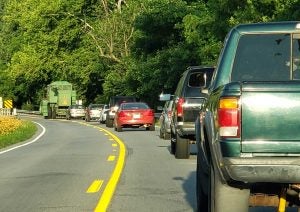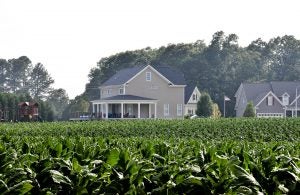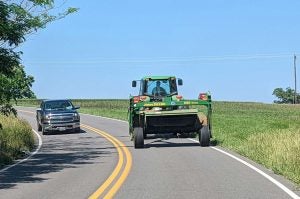With a windshield caked in dust and sunshine beating down, the farmer pulls his combine out of the field and onto the public road. And right into the path of a speeding car?
Observers are often left to wonder how this could have happened and why neither party was able to prevent it.
Whether the farmer was dazzled by the sunlight, or unable to see through a windshield fuzzed with crop residue, farm vehicle accidents are too often tragic in nature and certainly a phenomenon to be avoided. Additionally, the non-farming public needs to be aware that harvest time means more tractors, combines, and grain trucks will be on the road — and these are not nimble machines. Ultimately it takes all parties working together to keep people safe.

Tabby Flinn, Agriculture and Natural Resources Extension Educator for Purdue Extension in Vigo County, Indiana, said that in addition to workshops with farmers, her agencies make regular social media posts to alert the general public to the presence of farm vehicles throughout the year.
“Being stuck behind the combine five minutes isn’t going to ruin your day,” she noted.
National Farm Safety and Health Week has run annually the third week of September since 1944, but with work underway well before then in many parts of the country, it doesn’t hurt to start now to help prevent drivers from being caught in tragedy amid the traffic.
A ‘dazzling’
Hindsight is always 20/20 as the old saying goes, and thus many theories have been cooked up over the years to explain accidents that appeared, at least to observers, to have been avoidable. A social media video, for example, may get posted that makes it seem as if a tractor or grain truck driver intentionally pulled into the path of an oncoming car on a straight, flat roadway. Was sunlight in the eyes of the drivers in question, was there too much dust on the windshield, were the drivers overly tired, or perhaps the drivers were distracted by other devices?
Sun glare can indeed be cause for any motor vehicle collision, and studies have been done to back this up, even though every driver has experienced it. One study, titled Sun glare and road safety: An empirical investigation of intersection crashes, indicates that early spring and fall days — those times of year when the sun is more often lower on the horizon across prime U.S. farmland — present the highest level of glare.
And yes, that coincides with planting and harvest times.
That said, farm vehicles accidents can happen for many reasons. According to the Purdue Agricultural and Safety and Health Program, 25 people were killed in Indiana farm-related accidents in 2020. A part of the annual Indiana Farm Fatality Summary with Historical Overview, the reports note that this number is below the 50-year average of 30.2 annual farm-related deaths, but an increase over 2019’s tally of 21. Over the past 41 years, 1,115 Hoosiers have been killed in farm-related incidents, with more occurring in northern communities heavily populated by Amish/Old Order families. Of the 25 deaths in 2020, nine involved tractors and four off-road or utility terrain vehicles.
Bill Field, Purdue agriculture and biological engineering professor stated in a summary of the accidents, said, “Historically, farmers over the age of 60, including many who work only part time, have accounted for a disproportionate number of farm-related injuries. Recent spikes in frequencies of fatalities over the past 10 years makes this population of older farmers a special concern.”
The topic is likewise an issue of national concern, and according to a study published in 2021 in the Open Journal of Safe Science and Technology, these crashes peak during planting and harvest seasons, occur most frequently on rural roads, during the work week, and between the late morning and early afternoon hours. These are indeed times and seasons where sunlight is a much of an enemy as other factors.
“Especially since most harvest happens later in the day, and US roads are often oriented on a perfect 90° grid, so the probability that the setting sun will be right in your face is pretty high,” a Reddit user by the name of Drzhivago138 observed.
Couple that with longer working hours (commonly 12- and 14-hour shifts day after day, for multiple weeks) during planting and harvest seasons, and the risk compounds itself for agricultural producers.
Flinn said the problem of farm vehicle accidents is ongoing and ever present. “I don’t think it’s a growing phenomenon. It’s something that farmers will continue to deal with over the course of their lifetime.”

One of the factors to consider is the urban sprawl that has brought more non-farmers into rural areas, with subdivisions now tucked into the middle of cornfields. Officials say that drivers from the subdivisions speeding down rural roads just aren’t as cognizant of farm equipment being there compared with those raised on a tractor themselves.
And just as the farmer whose vehicle was struck may appear to have pulled out into traffic, it’s equally correct to ask how fast the other driver was going.
Farmers do report being able to see clearly enough in their vehicle until they turn into the sun, Flinn said, adding it’s tough to keep the windows clean when harvesting. But for their part, the agricultural community does emphasize road safety for producers, from adding warning blinkers and lights to machines to promoting awareness throughout social media.
Another factor to consider is the size of the equipment. Bigger combines mean more blind spots, and now as in the good old days, young people do a lot of driving.
What to do
Flinn said her agency works regularly with local emergency management teams to prepare for farm accidents, be they grain bin entrapments of vehicle crashes. Educating producers is one part of the solution, but so is public awareness.

Much like road crews repairing highways and police officers offering roadside assistance, farmers are providing a critical service to the community and often find themselves in harm’s way. Unpaved rural roads can be dusty, and overgrown brush along the sides can also hinder visibility.
Tractors and combines are noisy, and operators can’t easily see and hear everything around them. More public awareness of their presence can go a long way in increasing safety. And in the end it is a worthwhile cause as farmers feed the world.
Brian Boyce is an award-winning writer living on a farm in west-central Indiana. You can see more of his work at the Boyce Group homepage.



